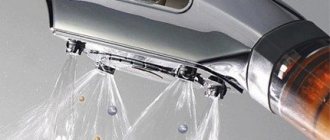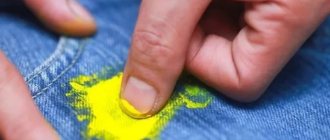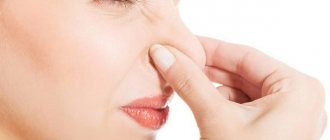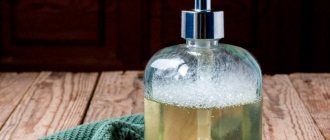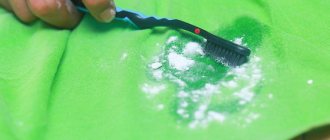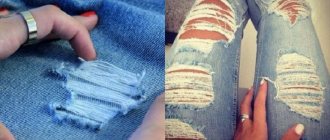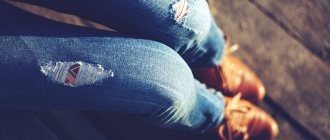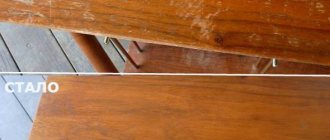Products made from denim have long been part of everyday life and have settled in it for a long time; it is very difficult to find a person who does not own jeans.
Caring for a piece of clothing is not difficult, clean it in time, refresh it, but first remove stains.
It is in the latter that many see the problem; not all usual means can remove stains on jeans without ruining them.
You shouldn’t be afraid of dirt of various origins; you can even remove old traces of grease, preserving the color and structure of the fabric.
The process is carried out in various ways, for which a variety of household products and substances are used.
Precautionary measures
To clean a grease stain on your favorite jeans (old or new) without damaging the color, decoration or fabric itself, you should follow some rules:
- To ensure that the stain remains intact, wash by hand and then use an automatic wash.
- If the machine has a "denim" function, only use it, otherwise the pants will fade quickly.
- Turn the item inside out before washing to preserve color.
- The temperature should not exceed 30 °C.
- Bleach should not be used.
- For colored clothing, use a stain remover.
Using these basic rules and recipes, you will restore your favorite activity without harm. However, try to treat stains as soon as they appear. Regular use of aggressive agents damages the tissue structure, even if the instructions are strictly followed.
What stain removers to use for greasy stains
If folk remedies cannot remove the oily blot, it is better to turn to the help of special preparations. There are several types of funds:
- Soap. There is a special Antipyatin soap that is recommended for pre-soaking and subsequent washing.
- Oxygen pencil (Meine Libe, Faberlic). Before removing the stain, moisten the stain with warm water and apply it with a pencil. Rinse the product after a quarter of an hour.
- Stain removers (Sarma, Vanish). Add the manufacturer's recommended dosage to the soaking liquid, then to the washing machine tray.
It is also recommended to use special aerosols against blots. Spray the product onto the blot and leave until washed, which will help completely remove the oily stain.
Drying clothes
It is necessary not only to do the main part of the work correctly, but also to dry the product properly. This process has its own nuances, knowing which you can prevent the item from drying out or shrinking.
Rules for drying jeans:
- After washing, the products are shaken, straightened and stretched in different directions. This simple manipulation will help maintain the size of the product and prevent shrinkage.
- When drying outdoors, it is best to secure your jeans to a rope at the waistband. You can do the same indoors or use a special trouser trampoline.
- It is not recommended to throw denim clothing over a rope, as after drying it may leave a mark that is difficult to smooth out.
- To maintain the brightness of the product for as long as possible, it is forbidden to dry jeans in open areas. This is necessary in order to protect the products from direct sunlight.
- To speed up drying (when drying in an apartment), you can create a draft.
- During the cold season, it is prohibited to dry trousers outside the apartment. In cold air, their fabric can freeze and become very fragile.
- In addition, it is not recommended to use heating devices and radiators for drying, as this can lead to severe shrinkage of the product.
Removing dirt from furniture upholstery
To clean furniture, you can use home methods:
- To preserve the color on the upholstery, dry cleaning with soda is used. To do this, sprinkle baking soda on the contaminated surface, leave the product for 1-2 hours, then remove it with a vacuum cleaner. If necessary, the procedure can be repeated.
- Wet soda cleaning is used to remove difficult stains. To do this, you need to moisten a soft sponge in water and walk it over the upholstery of a sofa or chair, sprinkle baking soda in an even layer on the damp surface and leave it for 20 minutes. After this, the contaminated areas are scrubbed with a sponge, and a vacuum cleaner is used on top to remove soda residues.
- Fresh stains can be removed with vinegar and dishwashing detergent. To cleanse, 1 spoon of each product is mixed and applied pointwise to the affected areas, leaving for 40 minutes. After this, the furniture is rinsed several times with a damp sponge or brush until the foam disappears.
In hot pursuit
As with any other stain, it is better to get rid of a greasy or oil stain right away. But unfortunately, trouble can take you by surprise, and a person may not have the opportunity to start washing immediately. In such a situation, a paper napkin or a piece of toilet paper will come to the rescue. It is necessary to blot the stain with them as quickly as possible. The paper will not completely remove fat, but it will also prevent oily substances from penetrating deeper into the fibers of the fabric.
Various tricks
By following certain rules for caring for good jeans, you can actually wear them for more than one or even two years. Interesting fact: this material in trousers can adapt to even small changes in a person’s figure. This applies primarily to the fact that the changes will not be too significant.
If the owner of the jeans has lost weight, but the pants themselves have stretched, then this situation can be saved as follows:
1. You can wash this item directly on yourself. To do this, you need to sit in your jeans in a bathtub with not very hot water, lather a sponge or your own hand with any soap and gently rub the fabric with it. After this, without removing the item from yourself, you must also rinse it on yourself with clean water. Now let the jeans dry again directly on the body.
Care at home without washing
1. If you have any stains on your jeans
, but you do not want to wash the products, then instead of washing, you can remove existing stains using water and a rag. If you use soap, be careful because the area where you try to remove the stain may discolor the fabric.
2. If you don't wash your jeans very often
, then it is recommended to at least ventilate them from time to time. Hang them out in the fresh air for at least 24 hours. Also, in order to eliminate various odors, it is recommended to use a deodorizing spray, which will do an excellent job of eliminating various unpleasant odors.
3. For those who very rarely wash their jeans
, there is another secret where you can simply freeze trousers in the freezer. Why do you need to do this? This is necessary so that bacteria can be killed, which are usually transferred from our body to the fabric and cause not very pleasant odors.
To get rid of bacteria
, you can simply put the trousers in the freezer, but keep in mind that in this case they will come into contact with food, so it is better to pack them in any paper bag or fabric bag that will allow air to pass through well, while a plastic bag is unable to do.
Before hanging your jeans on the line, you need to let them warm up a little.
4. If you've only worn jeans a couple of times
, this does not mean that they need to be washed, since they have a slightly different wear life. You need to wait until the jeans begin to sag a little in the back or stretch out at the knees, and also until they become loose at the waist.
What about the washing machine?
What to look for when choosing a mode? Look at the label. He will help you decide on all the necessary parameters and settings.
As for temperature, we look towards lower values. We'll be quite happy with 30–40. The number of revolutions should not exceed 800, otherwise the product will lose its entire appearance.
Based on these characteristics, the following modes are suitable for us:
- “For jeans” - found in many modern washing machines; you can choose it without hesitation.
- “Hand wash” - when selected, a delicate mode is launched, in which the device does not make full revolutions.
- “Delicate” is also one of the appropriate settings, just remember to look at the dashboard before starting and indicate the temperature is 40, the number of revolutions is about 800.
- “Mini 30” (on some devices “Fast 30”) - usually chosen for items made of dense fabrics and with minor dirt. The positive features of the regime include short contact with water and the elimination of overheating, which significantly reduces the risk of molting.
How to hide a stain on jeans
Unfortunately, some stains cannot be removed from denim due to the rough structure of the fibers. But this doesn’t mean it’s time to throw away your favorite trousers. You can try to hide a stain on jeans using decorative elements and jewelry.
The easiest way is to stick a patch on it. This option to cover a stain on jeans is more suitable for those who adhere to a youth or informal style of clothing.
You can creatively bleach the stained area: this will help diversify the look of your jeans and give them originality. The procedure is very simple: you should drop a drop of white on the stain and wait 5-15 minutes until the area of the fabric brightens. Later, add a few more highlighted spots or artificial abrasions to emphasize the intended style and give the product an organic feel.
Another original option: paint over the contaminated area. To do this, you can use regular acrylic or aerosol paint (spray can). The substance should be applied to denim and wait until it dries. To create a drawing or pattern, it is recommended to use paper stencils.
How to soften fabric if it has become stiff?
If your jeans become stiff after washing, you can fix this by using the following tips:
- Twist your pants and hit them on the corner of the table.
- Wrap the jeans in a bag and roll them with a rolling pin.
- Put your pants on, wet them with a spray bottle and go about your business. The wet fabric will become softer as you wear it.
- Wash the item again using fabric softener. If you don't have it, you can use hair rinse.
- Steam jeans using a steam generator.
Some users recommend washing jeans in a washing machine along with tennis balls.
This method must be used with caution. Balls cause additional friction to the fabric, which can lead to rapid wear. Although jeans do become softer after washing this way.
Useful tips
Removing stains, especially old ones, is always labor-intensive, so as not to use aggressive agents and reduce treatment time, follow these rules:
- Try not to leave the removal of contaminants of various origins until later; remove them as soon as possible.
- Use fresh products.
- Prepare solutions of several components before use, discard the remainder.
- Carefully read the instructions for using the stain remover.
- Do not over apply stain removers.
- Only wash your jeans after you have removed the stain. Don't add other things.
We found out how to remove a grease stain from jeans in the most effective way; everyone can choose the most suitable one on their own.
It's not difficult to remove stains, but it's better not to plant them. Take proper care of your wardrobe, remove dirt on time, and your clothes will last you a long time.
How to remove stains from jeans using traditional methods
The advantage of traditional methods over household chemicals is the ability to remove dirt from denim as delicately as possible. The most popular and inexpensive ways to remove stains from jeans with your own hands will be useful.
How to remove a stain on jeans with salt
We recommend reading: How to remove brilliant green from linoleum
Salt will help gently remove green grass stains left on denim. Algorithm of actions:
- pour a pinch of salt onto the contaminated area of the jeans;
- rub it using a small brush or cotton pad;
- after 10 minutes Rinse the item and wash it as usual.
Alternative method of using salt:
- pour 40 - 50 g of salt into a glass of warm water, stir;
- pour the resulting mixture onto the stain on the denim;
- leave for 5 - 10 minutes;
- rinse and put in the wash.
How to remove stains from jeans with chalk
Removing fresh stains on light-colored jeans is quite simple using ordinary chalk. If you don't have it, you can use tooth powder.
To do this, crush a small amount of chalk, then sprinkle it on the dirty area and thoroughly rub it into the fabric with a brush. After 15 min. remove the remaining powder and wash the product in the usual way.
How to remove a stain on jeans with mustard
Mustard powder can remove fatty and oily stains left on denim; apply a small amount of it to the stain and leave to react for at least half an hour, then rinse in clean water and wash with detergents.
Important! This method is suitable for removing stains from black or dark blue jeans.
How to remove old stains on jeans with laundry soap
Laundry soap effectively copes with all types of dirt. In particular, they can quickly remove blood stains from white jeans and remove grass or oil marks.
Important! For light-colored fabrics, you need to use soap with a bleaching effect. If you use regular yellow, it may leave some untidy-looking marks on your jeans.
The dirt must be scrubbed with soap. After this, chop a small piece and dilute it in warm water. Soak clothes in the resulting soap solution for 30 - 60 minutes. This can be done immediately, without pre-processing. Then the product must be rinsed and sent for washing.
How to clean a stain on jeans with hydrogen peroxide
It is not uncommon for jeans to develop yellow stains after washing. They appear if you use too much powder or wash denim clothes in hard water. You can remove yellow marks from fabric using hydrogen peroxide.
The product must be applied to the stain, rubbed and left for a few minutes. If you cannot remove the yellow stain from jeans, you can add a little ammonia to the peroxide and keep the resulting mixture on the fabric for 10 - 15 minutes.
How to remove a stain from jeans with starch
Food starch can quickly remove oil stains or greasy stains from denim. To do this, you need to apply a pinch of powder to the stained area, rub and leave for at least 5 minutes. If, after time, the mark is still visible on the jeans, the remaining product should be removed, and then freshly applied. The procedure often needs to be repeated two or three times for better cleansing.
How to remove a stain on jeans with sugar
Granulated sugar also works effectively in combating traces of oil or fatty foods (for example, mayonnaise or sour cream dripped onto jeans).
You can remove such a stain as follows:
- First, stains on denim need to be washed off with laundry soap, powder or bleach;
- then blot the material and pour in a small amount of sugar;
- Leave the product for 15 minutes, then wash as usual.
How to quickly remove a stain from jeans using specialized products
If you decide to use household chemicals, you need to take a responsible approach to choosing a powder, stain remover or washing gel. A detergent that is too aggressive can ruin the denim, its color and texture.
The most popular household chemicals most suitable for washing denim:
- Ariel powder in capsules. As mentioned above, it is not advisable to clean jeans with ordinary powders. But gels or capsules are ideal. Ariel is one of the most affordable capsule powders. It is capable of removing stains of any complexity from denim fabric.
- Gel Laska not only removes stains well, but also softens the material due to its conditioning effect.
- Flat is a specialized powder intended for denim. It is able to quickly remove stains and not spoil the color of the product.
- Oxygen stain remover Vanish can be classified as “heavy artillery”. It should be used if the contamination is so serious that it cannot be removed with more delicate means.
Varieties and methods of replacing them
The choice of stain remover depends on the composition of the stain. The principle of action is to destroy an organic or inorganic compound and remove it from the tissue.
Chlorine
Chlorine-containing compounds, for example, Whiteness, are used to bleach white cotton and linen items. At home, it can be replaced with a bleach solution. 30 grams per 1000 milliliters is enough.
Using a home stain remover has the same limitations and disadvantages as the professional method:
- premature wear of the fabric;
- yellowness on a white background;
- toxicity of odor and solution;
- use on fabrics with a dense, natural structure.
The use of chlorine compounds requires skin protection and ventilation.
Peroxide
Special stain removers contain oxygen, which oxidizes the organic components of the stain. At home, a substitute for store-bought stain remover would be hydrogen peroxide and soda ash. A pharmaceutical disinfectant will also replace chlorine-based bleach.
Perhydrol, when interacting with water, breaks down into oxygen and carbon dioxide. Soda ash softens the water, making the fabric easier to clean. For greater effect, the water temperature should be 70-80 degrees. For silk and wool, the temperature is reduced to 30-50 degrees. Homemade stain remover is not used for cleaning colored fabrics.
Chemicals require careful handling to avoid contact with mucous membranes and the gastrointestinal tract
Acid
Professional stain removers contain oxalic and hydrofluoric acids. They are used to remove iron oxides from cotton items. High toxicity and aggressiveness limits their use.
Table vinegar, artificial citric acid, and lemon juice have similar qualities in terms of interaction with inorganic substances.
Hydrogen peroxide and hydroperide
If you need to restore the whiteness of things, but you have neither laundry soap nor whiteness on hand, then just add 3% hydrogen peroxide or one hydroperide tablet to the water, and your T-shirt or socks will be snow-white.
These products work great on both thin and thick fabrics. You need to add 200 ml of peroxide or 10 hydroperide tablets to five liters of water and put the item that needs to be whitened into the solution. After 3 hours, clothes can be rinsed in clean cold water with added salt.
So if you are thinking about how to bleach a T-shirt at home, then you should resort to this method. You just need to wash it first, as usual. It is not recommended to wash things after peroxide or hydroperide; the reaction with the powder can be unpredictable.
